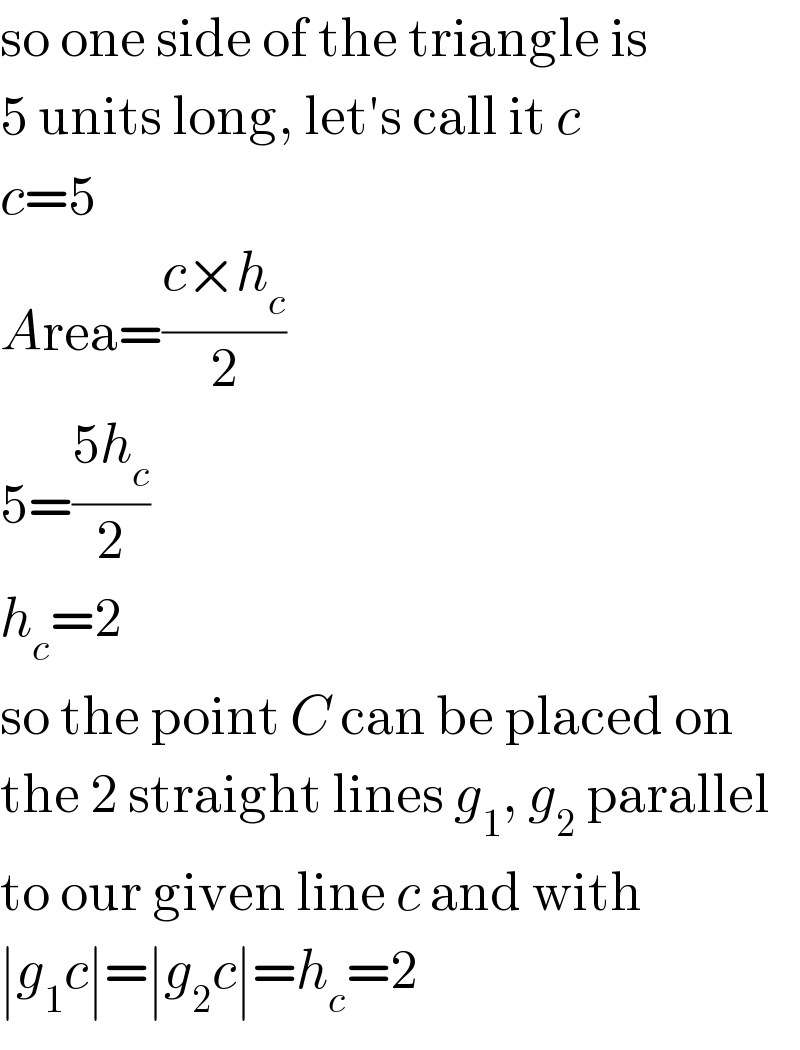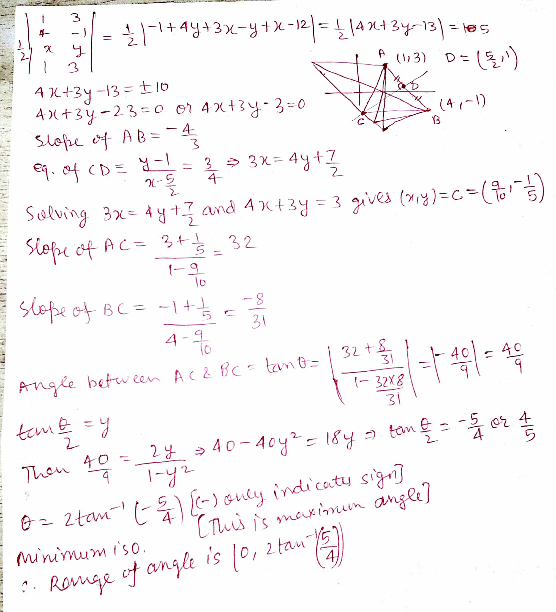
Question Number 31383 by rahul 19 last updated on 07/Mar/18

Commented by rahul 19 last updated on 07/Mar/18

$${but}\:{this}\:{ans}.\:{i}\:{am}\:{getting}\:{by}\:{assuming} \\ $$$${isosceles}\:{triangle}.\:{for}\:{general}\:{triangle} \\ $$$${how}\:{can}\:{do}\:? \\ $$
Commented by rahul 19 last updated on 07/Mar/18

$${ans}.\:{is}\:\left(\mathrm{0},\mathrm{2tan}^{−\mathrm{1}} \frac{\mathrm{5}}{\mathrm{4}}\right)\:. \\ $$
Commented by MJS last updated on 07/Mar/18

$$\mathrm{so}\:\mathrm{one}\:\mathrm{side}\:\mathrm{of}\:\mathrm{the}\:\mathrm{triangle}\:\mathrm{is} \\ $$$$\mathrm{5}\:\mathrm{units}\:\mathrm{long},\:\mathrm{let}'\mathrm{s}\:\mathrm{call}\:\mathrm{it}\:{c} \\ $$$${c}=\mathrm{5} \\ $$$${A}\mathrm{rea}=\frac{{c}×{h}_{{c}} }{\mathrm{2}} \\ $$$$\mathrm{5}=\frac{\mathrm{5}{h}_{{c}} }{\mathrm{2}} \\ $$$${h}_{{c}} =\mathrm{2} \\ $$$$\mathrm{so}\:\mathrm{the}\:\mathrm{point}\:{C}\:\mathrm{can}\:\mathrm{be}\:\mathrm{placed}\:\mathrm{on} \\ $$$$\mathrm{the}\:\mathrm{2}\:\mathrm{straight}\:\mathrm{lines}\:{g}_{\mathrm{1}} ,\:{g}_{\mathrm{2}} \:\mathrm{parallel}\: \\ $$$$\mathrm{to}\:\mathrm{our}\:\mathrm{given}\:\mathrm{line}\:{c}\:\mathrm{and}\:\mathrm{with} \\ $$$$\mid{g}_{\mathrm{1}} {c}\mid=\mid{g}_{\mathrm{2}} {c}\mid={h}_{{c}} =\mathrm{2} \\ $$
Commented by rahul 19 last updated on 08/Mar/18

$${so}\:{how}\:{does}\:{this}\:{proves}\:{that}\:{triangle} \\ $$$${is}\:{isosceles}?{how}\:{u}\:{get}\left(\mathrm{0},\mathrm{2tan}^{−\mathrm{1}} \frac{\mathrm{5}}{\mathrm{4}}\right)?? \\ $$
Commented by MJS last updated on 08/Mar/18

$$\mathrm{my}\:\mathrm{answer}\:\mathrm{proves}\:\mathrm{nothing},\:\mathrm{it} \\ $$$$\mathrm{shows}\:\mathrm{where}\:{C}\:\mathrm{is}\:\mathrm{possible}\:\mathrm{to}\:\mathrm{get} \\ $$$$\mathrm{an}\:\mathrm{Area}\:\mathrm{of}\:\mathrm{5} \\ $$
Commented by rahul 19 last updated on 09/Mar/18

$${ok},{thanks}! \\ $$
Answered by Tinkutara last updated on 08/Mar/18

Commented by Tinkutara last updated on 08/Mar/18
But many things are yet to think upon: (1) C must be point of intersection of perpendicular bisector of AB and the other parallel line for maximum angle ACB. I can't prove this but by drawing several points on that parallel line I see it should be such located… (2) The other line 4x+3y=23 is not considered… (3) The other root 4/5 is not considered…
Commented by rahul 19 last updated on 08/Mar/18

$${hmmm},\:{anyways}\:{thanks}! \\ $$
